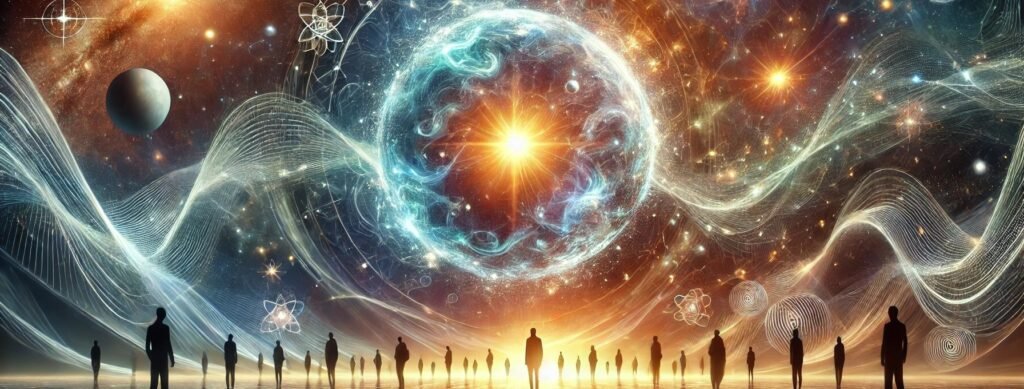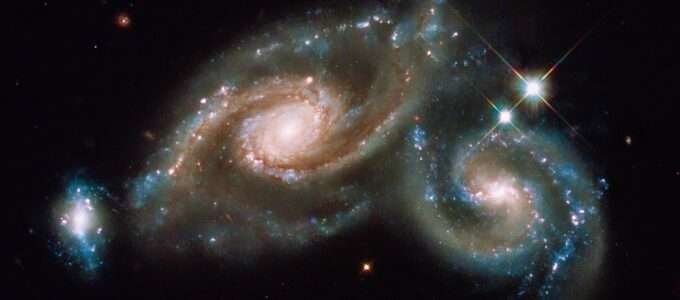Wheeler’s U and the Treasure’s Longing
What does it mean for the universe to exist? Is it an intricate dance of particles and waves observed into being or the expression of a primordial longing for self-recognition? When John Archibald Wheeler’s “U” meets the mystical proclamation, “I was a treasure longing to be known, so I created the universe,” we find ourselves at the crossroads of science and mysticism. These two perspectives—one rooted in quantum physics, the other in spiritual poetics—invite us to explore not just the nature of reality but the role of the observer in shaping it.
Podcast Discussion
A profound challenge underlies this exploration: the human sense of being a separate, independent entity—a perception born of dualism and the biological comparing mind. This illusion not only obscures consciousness’s unified, cosmic nature but also reinforces the belief that external events create reality. In truth, both Wheeler’s vision and the treasure’s longing point to a more profound recognition: consciousness is not produced by external events but is the fundamental nature of existence. The world arises from consciousness.

The Universe as Participatory Consciousness
Wheeler’s U depicts the universe as a participatory system, where observation is not passive but an active force shaping reality. The quantum foam at the universe’s origin symbolizes infinite potential, a seething field of possibilities. Human consciousness interacts with this potential in the present moment, collapsing it into specific forms through acts of observation.
This participatory framework challenges the classical view of an objective, independent reality. Instead, Wheeler’s model suggests that consciousness and reality are intertwined: without observers, the universe remains an undifferentiated sea of possibilities. However, Wheeler’s insight goes further—it hints that the observer is not an isolated individual but part of a greater, collective consciousness that participates in shaping the cosmos.
The Universe as Conscious Self-Expression
The mystical phrase “I was a treasure longing to be known, so I created the universe” offers a complementary perspective. Here, creation is portrayed not as a mechanical unfolding but as an act of divine self-expression. The hidden treasure symbolizes infinite, unmanifested consciousness. To know itself, it manifests the universe—a reflection of its essence.
This vision emphasizes that the world does not give rise to consciousness; rather, the world arises from consciousness. As conscious observers, human beings fulfill the treasure’s longing by perceiving, knowing, and embodying the divine essence. The act of observation, whether scientific or spiritual, is not separate from creation itself—it is the very means by which the treasure reveals and experiences its truth.
The Illusion of Separation
The recognition that consciousness is the fundamental nature of existence is obscured by the human tendency to see ourselves as separate, independent entities. This illusion arises from:
- Dualism:
Our perception divides reality into subject and object, self and other, creating the false impression of separateness. - The Comparing Mind:
The brain, wired for survival, constantly evaluates and categorizes experiences, reinforcing a sense of individuality. This comparison-based perception limits our ability to see the interconnected nature of existence. - Subjective Bias:
Each observer interprets reality through their unique lens of personal experiences, beliefs, and emotions. This subjectivity creates a fragmented view, making it difficult to grasp the unified nature of consciousness.
These factors challenge the recognition that the individual observer is not the sole creator of reality but part of a collective, unified consciousness. The world we see is not an objective external reality but a subjective projection shaped by individual and collective awareness.

“In His Image”
The biblical phrase, “God created man in his image,” takes on profound significance in this context. This statement does not refer to physical form but to the unique human capacity to reflect universal consciousness. Just as the treasure longs to know itself, human beings possess the ability to observe, create, and know—a mirror of the divine process.
This capacity is expressed in:
- Creative Power:
Like the treasure, humans bring potential into form through imagination, intention, and action. - Self-Awareness:
The ability to reflect on one’s existence mirrors the treasure’s act of knowing itself through creation. - Recognition of Unity:
By transcending the illusion of separateness, humans can recognize their role as participants in a universal consciousness.
Consciousness as the Source of Reality
Both Wheeler’s U and the treasure’s longing converge in their deeper implication: consciousness is primary, and the world arises from it. This perspective overturns the belief that consciousness is a byproduct of external events or physical processes. Instead, it suggests:

- Reality is not “out there”:
The external world is not independent of consciousness but arises from it, much like a dream arises from the dreamer’s mind. - The Observer is Integral to Creation:
As Wheeler’s observers collapse quantum potentials into reality, human consciousness creates the perceived world. - Unity Underlies Diversity:
Despite the apparent diversity of forms and experiences, all phenomena emerge from a single, unified field of consciousness.
Toward a Unified Understanding
To embrace this cosmic view requires transcending the limitations of the comparing mind and dualistic perception. It invites us to:
- Recognize the Illusion of Separateness:
The sense of being an independent entity is a construct of the mind. In truth, we are expressions of the same universal consciousness. - Shift from Individual to Collective Awareness:
Reality is not shaped by isolated individuals but by the collective participation of all consciousness. Recognizing this dissolves the boundaries between self and other. - See the World as Arising from Consciousness:
The external world is not something we observe passively but something we co-create. This realization aligns us with the deeper truth of our being.
The Ultimate Recognition
Wheeler’s U and the treasure’s longing lead us to a profound recognition: consciousness is the foundation of existence. In all its forms and phenomena, the universe expresses this consciousness seeking to know itself. To observe the world is to participate in its creation; to inquire into the nature of reality is to journey toward the heart of the treasure.
In this recognition, the boundaries between observer and observed dissolve. The world ceases to be a collection of external events and becomes an intimate reflection of consciousness itself. The treasure’s longing is fulfilled not through some distant, transcendent act but in the simple, profound act of being aware. In that awareness, we find not only the universe but the eternal presence of the treasure, shimmering at the core of all that is.


